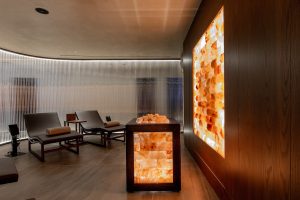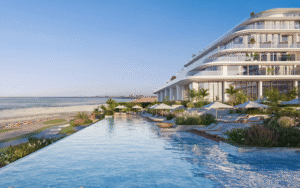Writer Pauline Brettell sifts through the trends that are directing the travel industry, to identify how these are impacting on hotel design both in terms of guest expectations and design deliverables….

Authenticity and experience are clearly the prevalent buzzwords in the travel industry as we shift our focus into 2024 and, now more than ever, the role hotel design plays in this process, is key. While the primary touchpoints that are visibly shaping hotel designs are not necessarily new – conversations around sustainability, hybrid hospitality, wellness have been going on for some time – what is new, are the the nuances and layers being devoted to these trends and how they are being integrated into the fabric of a project rather than adorning the surface.

Image credit: JW Marriott
Authentic experiences housed within a hotel that reflects its location, with a design that is as much a part of the experience as the local cooking class, is now all part of the expectation. In addition, travellers want to feel like they are actively supporting local communities and discovering something special. This immersive hospitality used to be the realm of alternative travel companies and small boutique hotels, but is becoming increasingly mainstream with the bigger brands embracing the concept. Take for example, the JW Marriott Madrid, where the history of the building – previously one of the oldest perfumeries in Madrid – has been incorporated into the design and the details, which includes giving guests the opportunity for a scent training workshop.

Image credit: Locke
Breathing design into the brand
With the design element of the hotel becoming a key factor on where guests choose to lay their personal hats, the designer is becoming part of the brand story and in many cases, brands are using designers to differentiate a property rather than making it fit into a brand standard. Locke has embedded this into its story, championing local design and community as part of its ethos. New properties are developed in tandem with the in-house design team and independent designers – Ember Locke openend in 2023, with interiors by Atelier Ochre and House of Dré, while more recently its Zurich property opened showcasing a collaboration with London-based design studio, Sella Concept.

Image credit: Locke
Hotel group Touriste have excelled at this, again, incorporating the designer into the brand story with properties like Hotel de la Boétie, brought to life by designer Beata Heuman who brings her imaginative take on Parisian style to her first hotel venture. Hôtel de la Boétie follows the trend of each of the Touriste portfolio, all of which have been designed by fashionable designers, with every one representing a design moment in time.

Image credit: Simon Brown / Touriste
Spa beyond limits
Wellness is another trend that is not only here to stay in all its guises, but in 2024, is predicted to be on steroids. No longer confined to a yoga class in the basement, in some cases it has actually become the brand, as with the immersive health and fitness brand from Kerzner International, Siro. What is new in this arena, is the expectation of personalisation, with guests in the luxury sector expecting not only wellness offerings, but ones which are curated to their needs. Additionally, wellness is being seen in a more holistic way, integrated into the fabric of a building and its people.

Image credit: Pnoé Breathing Life
Like all trends in the design arena there is a symbiotic relationship between them, as boundaries blur and nothing exists in isolation. Keeping the concept of authenticity at the core, these threads then run through the wellness offering as we see them increasingly being inspired by the location and the local culture – if the hotel is in or near a woodland, forest bathing finds itself on the agenda, while treatments on offer are increasingly taking inspiration from local plants and medicinal traditions. Ancestral Handmade Hotels has built this into its concept as a new regenerative wellness brand, aiming to revive and celebrate ancestral wisdom and tribal traditions at every step.
An additional file in the wellness folder is sleep and – according to a recent trend report form Hilton – travellers in 2024 will be investing in sleep with everything from pillow menus to circadian lighting, sleep and the quality of it, becoming a part of the hotel design conversation.
Low-carbon-impact design
Sustainability and low-impact design is fast becoming daily practice, having been spearheaded by the more agile, smaller boutique brands, with examples like 1 Hotel Mayfair and room2 paving the way. In both of these examples, sustainability is not just about getting rid of single-use plastic, but has been developed as part of the brand story and importantly, the company strategy. People and planet are both part of the process, with B Corp Certification becoming a benchmark.

Image credit: room2
The threads of sustainability again have become interwoven with the move to localisation, as brands need to be both sympathetic to local concerns and proactive in helping the community address local issues, to be seem as a force for good in the sustainability story. One of the fundamental points in all of this, is that while issues and concerns around questions of the environment have been around for some time, it is now being explored and embedded on a deeper level. It is about where the food that shapes the menu is sourced, it is about how far those roses on the reception desk have travelled, it is not only about what that candle next to the bed is made from, but also who made that candle and under what conditions. Alongside this, is a healthy expectation of transparency.
Shop while you stay
Retail is now increasingly part of the hotel experience fabric, with guests being able to – at the flash of a qr code – buy the handwoven throw that has been part of the experience. Product is part of the local story and being able to take a page out of the hotel design book home, extends the holiday. Retail is also, in many cases, the most direct and visible way of supporting the local community, from curated art work by local artists, cooking experiences by local groups or handcrafted items. Guests, quite literally, buy into the brand story via design.
An interesting example of this is Aman Cabana – a travelling, aspirational pop-up that will be taking luxury and branded collaborations to Aman locations across the globe during the course of 2024.

Image credit: Aman
On the flip side of all the talk about localisation and storytelling, which is generally a more immersive and tactile approach, is the role of technology, which is becoming increasingly important but, at the same time, kinder in its role in hotel design. Technology is now more about improving and simplifying, rather than complicating. While in some cases it is at the forefront, from the front desk through to room service, it is now more about controlling the functionality of the building and contributing to the sustainability of a design. It is about removing human error and ensuring lights, water and air temperature not only work for the guests, but work efficiently for the environment as well, while at the same time (co-incidentally?) cutting costs!
Main image credit: Nicholas Worley






















